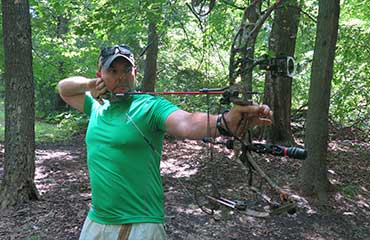I got one of my best bow bucks 10 years ago, and while some details of that hunt are now fuzzy, one of the lessons it taught never fades. The takeaway? Extending your effective shooting range can pay huge dividends, and now is the time to get it done.
The buck that got me thinking was a heavy, mainframe 10-pointer that I arrowed during the peak of the rut, right at 40 yards. It was a shot I took in complete confidence following a spring and summer of diligent shooting practice. My goal that year had been to extend my effective range, and I worked hard to do that, shooting regularly at longer ranges. Come September, I had never been more confident in my shooting abilities.
Many bowhunters, especially whitetail hunters, go to the woods envisioning a short-range shot. They practice at short ranges and set up their stands for close-quarters encounters. And that’s all well and good. I’m a firm believer that bowhunting at its best is an in-your-face, point-blank game. That’s always been my goal, and it should be yours as well.
But how much would it boost your odds of success if you were to extend that range even a little?
Let’s say your effective range is 20 yards, or that you have set up your stand so that you can shoot 20 yards in any direction. How much more area would you really be covering if you improved your shooting skills, or arranged your stand so you could shoot out to 30 yards?
Most bowhunters are surprised to learn that extending their range from 20 to 30 yards actually more than doubles the amount of area they are covering. For proof, let’s take a look at the math. With a 20-yard shooting radius, you are covering a circle of 1,256 square yards. With a 30-yard radius, it is 2,826 yards. Even if you can shoot over only part of the circle, you are still covering 2 1/4 times more area by being able to shoot accurately at 30 yards. Eye-opening? Absolutely.
Whether this exercise in math translates into more than doubling your chances of success depends on a variety of factors, such as whether you truly have attained 30-yard effective accuracy. Still, one benefit is virtually undeniable. A deer in that 20- to 30-yard band is much less likely to detect you than it would within the original 20-yard circle.
You can compare area of coverage for any shooting range with the formula for the area of a circle, which is pi (r2), or 3.14 x shooting range squared.
The buck that got me thinking was a heavy, mainframe 10-pointer that I arrowed during the peak of the rut, right at 40 yards. It was a shot I took in complete confidence following a spring and summer of diligent shooting practice. My goal that year had been to extend my effective range, and I worked hard to do that, shooting regularly at longer ranges. Come September, I had never been more confident in my shooting abilities.
Many bowhunters, especially whitetail hunters, go to the woods envisioning a short-range shot. They practice at short ranges and set up their stands for close-quarters encounters. And that’s all well and good. I’m a firm believer that bowhunting at its best is an in-your-face, point-blank game. That’s always been my goal, and it should be yours as well.
But how much would it boost your odds of success if you were to extend that range even a little?
Let’s say your effective range is 20 yards, or that you have set up your stand so that you can shoot 20 yards in any direction. How much more area would you really be covering if you improved your shooting skills, or arranged your stand so you could shoot out to 30 yards?
Most bowhunters are surprised to learn that extending their range from 20 to 30 yards actually more than doubles the amount of area they are covering. For proof, let’s take a look at the math. With a 20-yard shooting radius, you are covering a circle of 1,256 square yards. With a 30-yard radius, it is 2,826 yards. Even if you can shoot over only part of the circle, you are still covering 2 1/4 times more area by being able to shoot accurately at 30 yards. Eye-opening? Absolutely.
Whether this exercise in math translates into more than doubling your chances of success depends on a variety of factors, such as whether you truly have attained 30-yard effective accuracy. Still, one benefit is virtually undeniable. A deer in that 20- to 30-yard band is much less likely to detect you than it would within the original 20-yard circle.
You can compare area of coverage for any shooting range with the formula for the area of a circle, which is pi (r2), or 3.14 x shooting range squared.




.png)